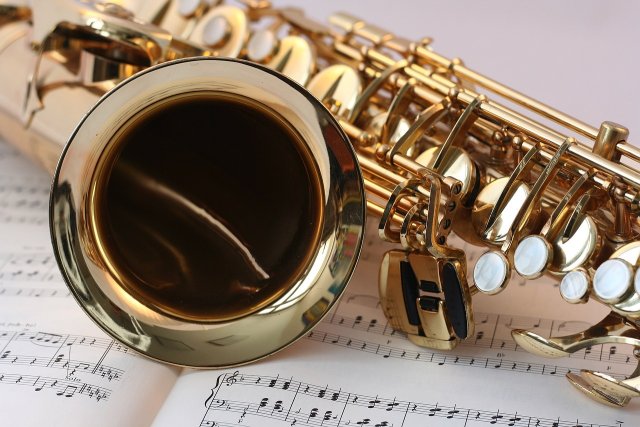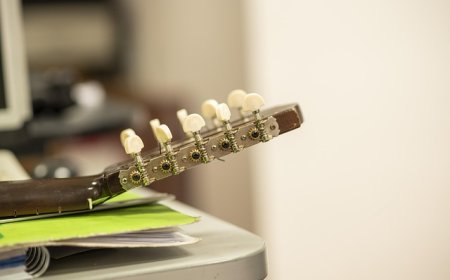Saxophone Facts for Students | Learn How the Saxophone Works & Its History
Discover the saxophone—its parts, how it works, history, famous players, and fun facts. A student-friendly guide to this cool and powerful woodwind instrument.

🎷 All About the Saxophone
🥇 Introduction
The saxophone, or sax, is one of the most popular and exciting instruments in the woodwind family. Even though it's made of shiny brass, it's a woodwind instrument because it uses a single reed to make sound, just like a clarinet. The saxophone has a bold and smooth sound that works well in many styles of music, especially jazz, pop, rock, marching bands, and concert bands. It's loved by students and professionals for its fun personality, wide range, and cool look.
🎶 What Is a Saxophone?
A saxophone is a single-reed woodwind instrument with a conical metal body. It’s played by blowing air through a mouthpiece with a reed attached. The reed vibrates and produces sound, which travels through the curved brass body and comes out the bell. Saxophones have a wide range of notes, and players use their fingers to press keys that open and close tone holes to change pitches.
There are several types of saxophones, each in a different size and pitch. The most common ones are:
- Alto saxophone – Medium-sized and great for beginners
- Tenor saxophone – Larger and has a deeper tone
- Soprano saxophone – Small, straight, and high-pitched
- Baritone saxophone – Big and low, with a deep, rich voice
All saxophones use the same basic fingerings, so players can switch between them once they’ve learned one.
🧹 Parts of the Saxophone
The saxophone has several important parts that help produce and shape its sound:
- Mouthpiece – The top part that holds the single reed. The player blows into this to start the vibration.
- Ligature – A metal or plastic band that holds the reed onto the mouthpiece.
- Neck (or Crook) – A curved tube that connects the mouthpiece to the body.
- Body – The long section with most of the keys, rods, and tone holes. It’s made of metal and often lacquered for shine.
- Bell – The flared end where the sound comes out. It helps project the sound forward.
The saxophone also includes palm keys, thumb rests, pads, and springs to help the player control every note.
⚙️ How Does the Saxophone Work?
The saxophone produces sound when the player blows air through the reed on the mouthpiece. The reed vibrates against the mouthpiece, creating sound waves. These vibrations travel through the body of the saxophone. The player changes notes by pressing keys that open or close tone holes, changing the length of the air column inside the sax.
The saxophone is a transposing instrument, which means that what’s written in the music isn’t the exact pitch that sounds. For example, an alto saxophone is pitched in E♭, and a tenor saxophone is in B♭.
The saxophone is known for its rich, reedy tone, and it can play both smooth melodies and powerful solos. It blends well with both brass and woodwinds, which makes it a favorite in many musical groups.
📜 History of the Saxophone
The saxophone was invented in the 1840s by Adolphe Sax, a Belgian instrument maker. He wanted to create a new instrument that would blend the powerful sound of brass with the flexibility of woodwinds. The saxophone was originally meant for military bands, where it could be loud, clear, and expressive.
Although it wasn't widely accepted in classical orchestras, the saxophone found a huge following in jazz in the early 1900s. Jazz musicians discovered that the sax could bend notes, improvise, and express emotion in new ways. It became the voice of the Jazz Age, thanks to players like Sidney Bechet and Charlie Parker.
Today, the saxophone is heard in all kinds of music—concert band, marching band, jazz, pop, funk, soul, and even classical music. Its sound is unforgettable, and its story continues to grow.
🎷 Famous Saxophone Players
Here are some of the most famous and inspiring saxophonists:
- Charlie Parker – A bebop pioneer known for his fast, brilliant playing on alto sax
- John Coltrane – A jazz legend famous for his powerful tenor sax solos
- Kenny G – A smooth jazz artist who made the soprano saxophone popular in pop music
- Cannonball Adderley – Known for his bluesy, joyful alto sax playing
- Lisa Simpson (fictional) – A cartoon character from The Simpsons who made the saxophone cool for kids!
These musicians helped shape the way people hear and play the saxophone today.
🎶 Learning to Play the Saxophone
The saxophone is a great choice for beginners who want a powerful, expressive sound and enjoy playing with others in bands. Most students begin on the alto saxophone, which is smaller and easier to hold than the tenor or baritone sax.
Beginners learn how to assemble the sax, moisten and place the reed, and produce their first sound. They practice simple fingerings, long tones, and basic songs. Reading music in treble clef and learning breath control are important early skills.
As students grow, they can explore jazz improvisation, join concert bands or marching bands, and even perform solos. Saxophone players are always in demand in school music groups, and learning the sax can be a fun and exciting journey for young musicians.
😄 Fun Facts About Saxophones
Here are some fun and surprising facts about the saxophone:
- Even though it’s made of metal, the saxophone is a woodwind instrument!
- The saxophone was invented by one person, Adolphe Sax, in the 1840s.
- There are over a dozen types of saxophones, from the tiny sopranino to the huge subcontrabass sax.
- The reed on the saxophone is made from a special plant called Arundo donax.
- Saxophones are common in marching bands, jazz bands, funk, rock, and even classical music.
- The saxophone family includes instruments in many shapes and sizes, from straight to curvy to enormous!
👧 Kid-Friendly Summary
The saxophone is a shiny, curvy instrument that looks like brass but is actually part of the woodwind family. You play it by blowing into a mouthpiece with a reed, and pressing keys to make different notes. The saxophone sounds bold, smooth, or jazzy—and it’s used in lots of fun music, like jazz, pop, and band songs. If you want an instrument that stands out and lets you play solos, the saxophone is an awesome pick!
📚 Vocabulary Words
Saxophone – A woodwind instrument with a single reed and a metal body
Reed – A thin piece of cane that vibrates to make sound
Mouthpiece – The part of the sax where the reed and ligature attach
Ligature – A small band that holds the reed onto the mouthpiece
Bocal (for some saxes) – A curved tube that connects the mouthpiece to the neck
Tone hole – An opening that changes pitch when opened or closed
Transposing instrument – An instrument where the written note is different from the sounding note
Treble clef – The musical staff used for reading saxophone music
❓ Interactive Quiz
1. What makes the sound on a saxophone?
A. A double reed
B. A bow
C. A single reed
D. A drumstick
2. Who invented the saxophone?
A. Charlie Parker
B. Louis Armstrong
C. Adolphe Sax
D. John Coltrane
3. What type of instrument is the saxophone?
A. Brass
B. String
C. Woodwind
D. Percussion
4. What is the most common saxophone for beginners?
A. Soprano
B. Alto
C. Baritone
D. Tenor
5. In what kind of music is the saxophone most famous?
A. Jazz
B. Opera
C. Heavy metal
D. Gregorian chant




















































